- Read about author’s
personal experiences of a ten day Vipassana course. She also shares day wise
schedule, code of discipline, daily schedule, learnings and benefits, what
worked and what did not work for her.
Four years back
when my sister did her ten day Vipassana course, I looked at her with disdain
and thought how could she waste ten days doing nothing but meditating. I told
her if I ever were to get these many days, I would rather go on a trek than
spend time on Vipassana in silence and isolation.
Fast forward to
November 2017, I have now completed a ten day Vipassana course and I can’t help
but chuckle at the idea of saying ‘no’ to anything else in life. For those of
you who don’t know what this is; it’s ten days of meditation close to eleven hours
a day. One is not allowed to speak, make eye contact, read, write, listen to
music, sing, exercise, or indulge in any form of entertainment (no phones,
book, diary etc). Women and men are segregated and first meditation begins at
4.30 am.
I am sure many of
you will be like..no way! I too was a few years back until I decided to go.
Hope my experience will give insights and information about this course.
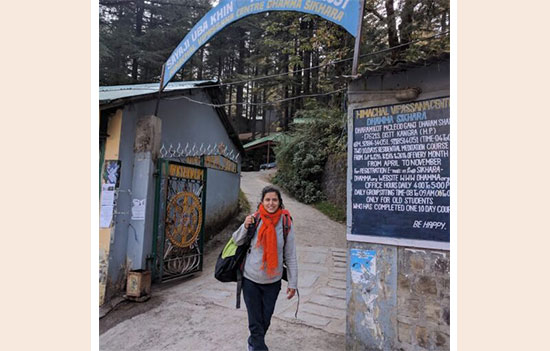 Entrance.
Entrance.
As I left the
Vipassana center at Dharamkot (Dharamshala, Himachal Pradesh) on the morning of
November 12, Gautam (my husband) was walking up the mountain trail to receive
me. His eyes lit up as he came closer to welcome me back to the real world. As
we walked to where he was staying, I felt as if I was shuttling between two worlds.
Back in the balcony of our room overlooking the valley and McLeod Ganj, we
sipped hot tea and he asked me about my last eleven days. Read on.
Due to my avid
love for mountains, I always wanted to do Vipassana at the Dharamkot center.
Since I had already done my Buddhism course at Tushita Center at Dharamkot in
2016, I knew the area. Since the course gets booked in advance, I remember
staying awake until midnight one day in early September to reserve my seat in
the course. In fact, I had registered for the course last year also, which I
couldn’t attend somehow. That’s why everyone expected me to bail this year as
well. But little did I know what lay ahead.
The ten day course
is an introductory course to Vipassana Meditation. It is ten days of meditation
that ends on the morning of the 11th day by 7.30 am.
Vipassana means to see things as they really are. An insight into the true nature of reality. It is a way of self-transformation through self-observation. It focuses on the deep interconnection between mind and body, which can be experienced directly by disciplined attention to the physical sensations that form the life of the body, and which continuously interconnect and condition the life of the mind. It is this observation-based, self-exploratory journey to the root of mind and body that dissolves mental impurity, resulting in a balanced mind full of love and compassion.
Why
I went for Vipassana
Somewhere in life,
all of us lose touch with reality and become robotic beings going about our
daily lives. I know I did. Anger, happiness, joy, sadness all sit huddled next
to each other and we are always ready to react quickly at the slightest of
things in life. It’s as if you lose touch with your real self. That’s how it
came to pass for me as I found myself at the crossroads of my life with
overwhelming emotions, anger, and I realized that something had to change in my
life.
Although I had
taken a few other meditation courses, I had always been intrigued by Vipassana.
It seemed more like a challenge that I wanted to face. I knew that it was
unlike mountaineering and had its own challenges. Merely sitting for hours at a
stretch and meditating was something that was alien to me. But before I signed
up, I knew I could do it. I would be able to last 11 days of intense
meditation, silence and come out with a better understanding of myself.
At the end of the
course, by digging into my psyche, I was able to realize that the joy that we
feel in our daily lives is impermanent. True happiness waits further away along
the shores of our soul’s realm. It could never be purchased, but only be
experienced through self-inquiry and awareness. My journey through the course
Day
0
The overnight bus
from Delhi got me into McLeod Ganj around 6 am. On reaching, I caught a rickshaw
to Dharamkot where I had breakfast and tea. After whiling away some time, I
entered the Vipassana center around 11 am where men and women were segregated.
We were led to our
meditation rooms, which seemed more like a cell with only a bed and a table.
After putting away my luggage, I wandered around Dharamkot and returned back to
the Center at 2 pm for registration and check in any belongings that were not allowed
inside the center.
I said goodbye to
my phone, food items, diary, books etc. for the next eleven days. For me
personally, food was going to be the biggest challenge considering the limited
meal options available during the course. The volunteers who helped organize
the course seemed friendly and so did the other female course mates with whom I
interacted. The meditation room, which would be my home for the next 11 days,
made me slightly claustrophobic at first. In the evening, we were briefed on rules
and regulations and on the principle of noble silence.
All who attend
Vipassana course must conscientiously undertake the following five precepts during
the course. Namely to abstain from killing any being; to abstain from stealing;
to abstain from all sexual activity; to abstain from telling lies and to
abstain from all intoxicants.
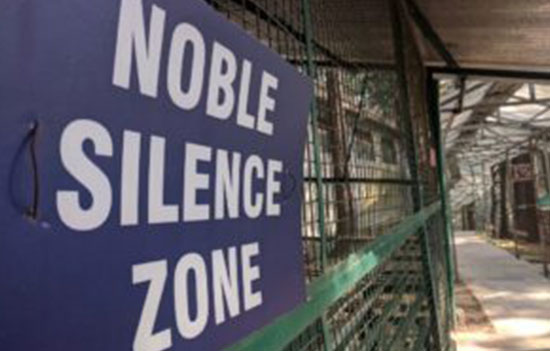 Silence Zone.
Silence Zone.
The
Code of Discipline
The foundation of
the practice is sila-moral conduct. Sila
provides a basis for the development of samadhi-concentration of mind. Purification
of the mind is achieved through panna-
wisdom of insight. Noble silence was to be strictly followed and no interaction
was allowed. After 8 pm, the noble silence began and we were to observe it for
the entire duration of the course. After having khichdi for dinner, we retired
to our rooms. From 4.30 am the next day, the meditation regime would begin.
Daily
Schedule
Morning wake-up
bell.
Meditate in the
hall or your room.
Breakfast break.
Group Meditation
in the hall.
Meditate in the
hall or in your room according to teacher’s instructions.
Lunch break.
Rest and
interviews with teacher.
Meditate in the
hall or your room.
Group Meditation
in the hall.
Meditate in the
hall or in your room according to teacher’s instructions.
Tea break.
Group meditation
in the hall.
Teacher’s
discourse in the hall.
Group meditation
in the hall.
Question time in
the hall.
Retire to your
room – Lights out.
Day
1-10
This was to be our
daily schedule from day 1-10. The toughest thing was to get up at 4 in the
morning. You can’t escape the loud gong, which is rung and after that all
sevaks (volunteers) come at your doorstep and keep ringing the bell until you
wake up. First morning meditation happens from 4.30 to 6.30 am.
Designated places
in the meditation hall are allotted to all students with males and females
segregated. Dharamkot Vipassana Center is surrounded by pine and Deodar (Cedar)
trees and sun intermittently shines flirtatiously through the leaves. Since it
was early November and the beginning of winter, there was a slight nip in the
air and we would reach the meditation hall bundled in warm shawls.
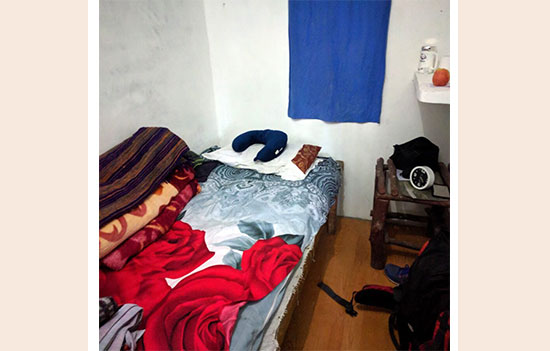
Dharamkot center has a lot of monkeys and one girl was bitten by a monkey so I was forced to break my silence to allow the Doctor in me take charge and give her appropriate vaccination.
Lunch is served at
11 am and consists of Rice, Roti, vegetables, daal mildly spiced without onion
and garlic. There is no dinner, but puffed rice and tea are given at 5 pm. For
old meditators, only lemon water is provided at 5 pm. I thought I wouldn’t be
able to manage without regular meals, but as the course progressed, I realized
that I did not need that much food.
During rarely
available free time, I would watch the monkeys create havoc, Sun playing hide
and seek, listen to rustling leaves and heaving winds. Since it was chilly in
November, we were in woolens. Laundry facility is available at nominal charge.
If you have any special food requirements, it is not provided. One lady in our
batch was pregnant and adequate meals were provided for her. All our meditation
and other sessions started with the sound of the gong, which directed our day
instead of our watches. By 9.30 pm, everyone was in bed.
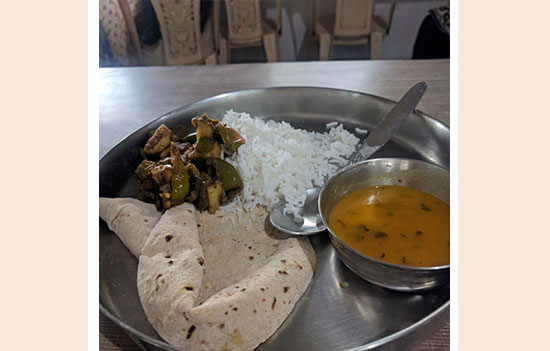
The first three
days of meditation are Anapana
Meditation, which means mindfulness of breathing followed by observing
sensations around and below the nose area. From 6.30 to 8 am, I had free time.
During this time, I would have breakfast followed by a shower. Breakfast was wholesome
with tea, cereal, fruits, etc. We were supposed to wash our utensils after each
meal. It was quite striking to see such a large group of people (meditators)
dining together without a word or gesture being exchanged with anyone.
Vipassana
meditation is free for all and in the end you may make a donation. I earnestly
appreciated the selfless service of volunteers during the course.
On some days, the
long hours of meditation became really tedious. I wish there was Yoga or some
sort of physical exercise available for our aching bodies from long hours of
sitting and meditation. I looked forward to respected SN Goenka’s teaching in
the evenings as it was a welcome detour from long hours of meditation. I used
to listen to discourses in English as I found it hard to follow the ones in
Hindi. Goenka Ji’s discourses are always focused on having realization through
direct experience and not at intellectual level.
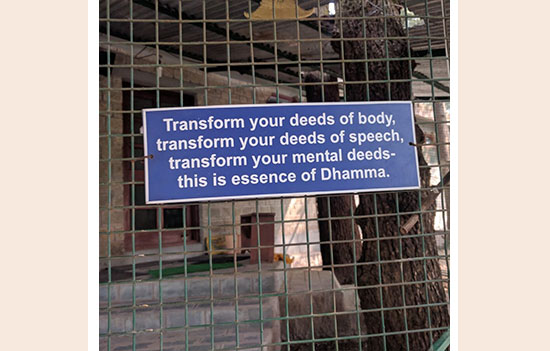
For
the first three days of the course, I had zillion thoughts buzzing through
my head refusing to go, but the best thing was to watch your thoughts come and
go and concentrate on your breath. Around 10-12 hours of meditation happens
each day and at times, it becomes very hard to sit in the same posture for
extended periods of time. Each minute feels like an hour. Chairs and backrests
are provided for people who need them.
Personally, I
wanted to run away and leave the course on the third day as the long hours of
meditation seem to never end and the endless thoughts frustrate you. In
hindsight, I’m glad that I endeavored to persevere and successfully finished
the course. Around 6-7 female students left the course midway. On day 4, I
started reading the labels on my shampoo bottles and collecting pebbles. I read
instructions and details outside the meditation hall a million times. My mind
begged for intellectual stimulation.
From
the fourth day
onwards, one is taught Vipassana meditation, in which one experiences and
observes bodily sensations and merely observe them without having aversion or
craving. It focuses on maintaining an equanimeous state of mind and observing
life unfold as a detached self. It puts great emphasis on having an inner
discourse devoid of rituals and mantras. It talks about having deep compassion
for all beings and understanding the nature of misery, which is attachment.
Anicca or impermanence
means that everything shall pass and nothing remains forever. By watching our
gross and subtle sensations come and go, we delve deeper into the phenomenon of
anicca and can incorporate it in our daily lives. During long hours of meditation,
my whole life flashed in front of me. I relived all moments of anger, tears,
frustration, loss, happiness, hidden fears, aspirations, and dreams. And yet as
I finished my course, I found this deep sense of calmness, that indescribable
happiness, that quiet mind and overflowing joy and abundance.
Vipassana starts
with observing sensations in each body part and as you progress, you do
multiple body scans and observe different sensations as a detached self with an
equanimeous state of mind.
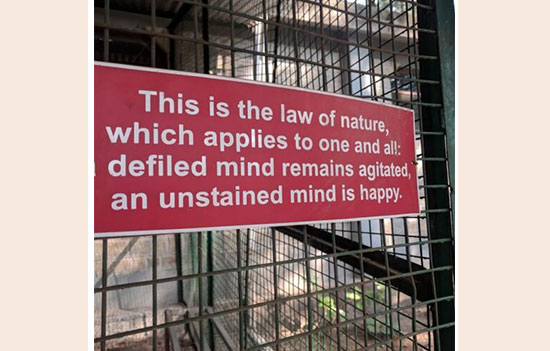
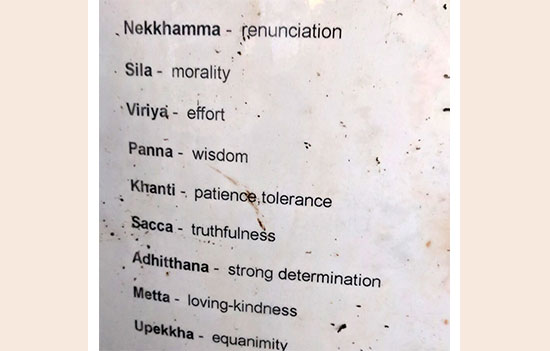
Day
11: Metta day
This is the last
day of meditation and the day to meet and greet. Morning meditation happens as
usual followed by Metta meditation from 9 to 10.15 am and after that the noble
silence ends. Joyful faces are all around, chatting and sharing their experiences.
We got all our stuff back except for mobile phones which we received at 4 pm. I
was ecstatic to get back my diary and write about my experiences.
One can make a
voluntary donation of whatever amount one wants or feels. Then special lunch is
served followed by meditation and metta chanting “sabka mangal ho”, a prayer for wellness of all beings. At the end
of meditation, I was all in tears and left the place with more compassion,
awareness and peace, realizing that bitterness towards people, situations would
only make me bitter and embracing life without judgment will help me grow as a
person. We all chatted till late night and we were full of contentment. Our
faces were brimming with the radiance of inner joy. I slept with sheer joy and
gratitude.
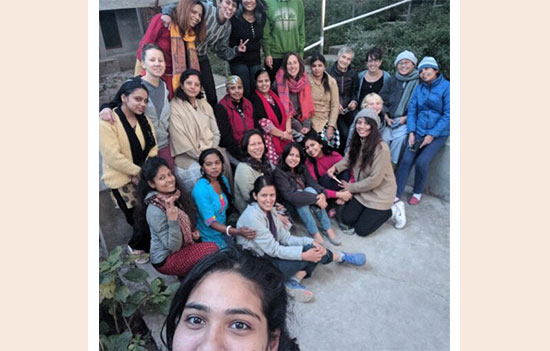
On
the morning of day 12, I left to face the real world and seeing my husband
waiting at the gate smiling made me realize how his absence made me aware of
his everlasting presence. Because without his support and encouragement, I
would have pushed it to some other year. We sat on a bench in solitude and I
shared my experiences with him after which we went to our favorite cafe in
Mcleod Ganj to savor some hot tea and homemade bread.
What
worked for me?
1. We are slaves
of our mind and like a computer program, our reactions are preset.
2. Vipassana
taught me to observe as a detached self and with an equanimeous state and then
how so ever I react will not be an unconscious predetermined response.
3. Happiness is
not outside.
4. There is no end
to craving and the real journey is within.
5. Helped me in
quieting my inner turbulence and anger.
6. No one else
could do it for me. I had to make an effort. Not to forget the body aches and
numbness.
7. This too shall
pass, the good and the bad.
8. Enjoy every moment
in the fact that it is ephemeral. Love without attachments and clinging.
9. I could sit
through traffic and honking without excessive cursing.
10. Take what
works for you.
What
did not work for me?
1. There is no
emphasis on posture or breathing.
2. We are asked to
stop taking all non-prescription medicine and stop any previous spiritual
practices during the course.
3. I felt drowsy,
bored and lethargic due to long hours of meditation.
4. The course did
not include any physical yoga.
5. Not allowing assimilation
of other practices, rituals or mantras.
6. Teachers are
not equipped enough to clear doubts.
7. After sometime,
lectures become tedious and repetitive with over
emphasis on the fact that Vipassana is the best technique.
8. Ending of course was too abrupt. Not a word from the
teacher on course completion. Only relying on Goenka’s lectures.
9. Not exactly
non-sectarian as claimed during the course. There is a lot of Buddhist
influence in techniques.
10. I didn’t like
complete segregation of men and women.
After all these
days of meditation, I realized that sitting silently and doing nothing is not
quite as easy as it might seem. I would invest time in adjusting my pillow’s
position to make it comfortable. Yet, as my mind quietened towards the end, I
enjoyed it and no longer waited for it to end. I sobbed, cried and deep
catharsis took place inside me during the course and I realized the art of
living. It is not easy because for the first time, you come face to face with
reality and are witness to bitter truths of your life, which you always evaded.
Be well and thanks
for reading.
This was first published on the author’s site and Here
eSamskriti has got permission from author to share. Author wrote this piece in
January 2018. Author website is www.varunaraina.com
Also read
1. Mcleodganj
album
2. Dalhousie,
Khajjar album
3. Vipassana Meditation
4. Chamba
Valley album